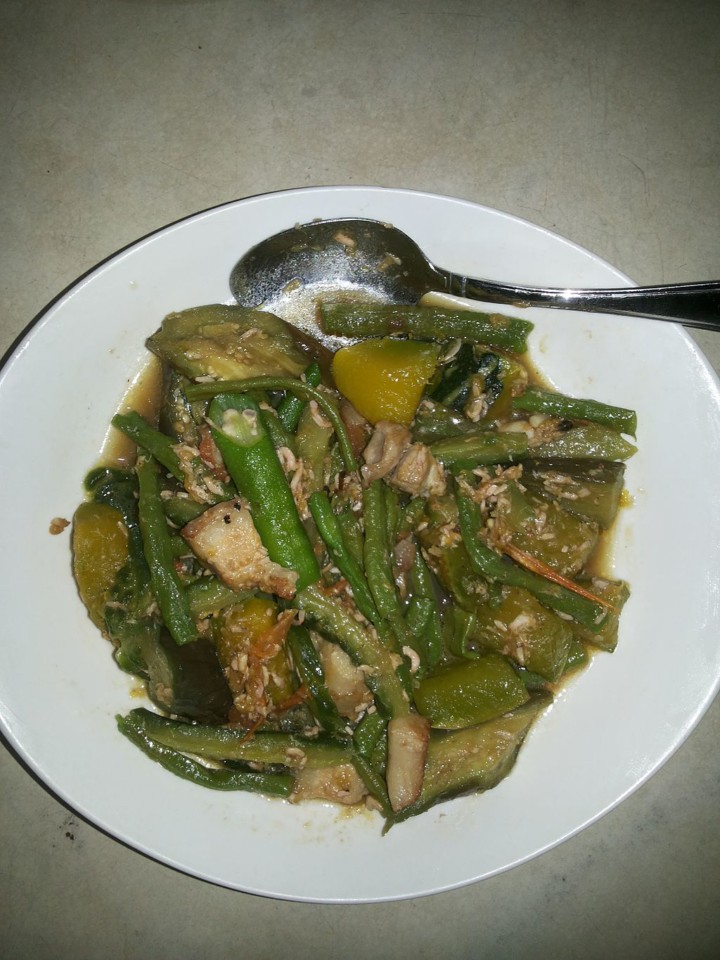Although most visitors to South East Asia love the food, there’s one gripe I often hear — where are the vegetables?
Of course, we all know they’re here, a visit to any market will reveal an astonishing range of wonderful local produce. But it often seems as though they rarely make it to the table, or if they do they’re hidden away, almost apologetically.
With such an amazing abundance, why aren’t these delicious healthy foods really celebrated, and put firmly at centre stage?
In the Philippines there is a wonderful dish that does exactly that, and it’s called Pinakbet.
The name of this dish is a contracted form of the Ilokano word “pinakebbet” which means “shrunk” or “shrivelled” — a clue to the desired texture of the finished dish.
As well as being healthy and delicious, the best thing about Pinakbet is that it’s cheap. Other than some shrimp sauce (replacements will be discussed later) all you need are the vegetables — and even a huge bagful from the market won’t break the bank.

The dish
The version presented here includes pork belly, but this isn’t essential. The dish can be entirely vegetarian, or even vegan, should you chose. Other meats can be used, and some chefs add whole shrimps for a really decadent feel.
For those who don’t like the taste of fish, the shrimp sauce (or fish sauce for those with allergies) can be replaced with soy sauce, along with a little extra salt.
The list of vegetables given below is absolutely not set in stone — depending on your preferences and what’s available at market you can experiment to your heart’s content. (Personally, I’m not keen on okra, so I leave those out).
Although a straightforward dish, there is an element of judgement in the timing of adding the vegetables, as some take longer than others to cook (so put them in first). This is common sense, really, and practice will make perfect.
Although a hearty dish in itself, Pinakbet is usually served with rice — which, for once, plays second fiddle to the vegetables.
Serves four
Ingredients
1 tablespoon oil
1 small onion, peeled and chopped
2 cloves garlic, peeled and minced
½ pound pork belly, cut into 1-inch cubes
1 tablespoon shrimp paste (or fish sauce or soy sauce)
2 medium tomatoes, chopped
2 cups water
½ small calabasa (a type of squash) peeled and cut into pieces
6 to 8 okra, ends trimmed
½ bunch long beans, ends trimmed and cut into into 3-inch lengths
1 ampalaya (bitter melon), seeded, halved and cut into 1-inch chunks
1 large eggplant, ends trimmed and cut into 1-inch chunks
Salt and pepper to taste
Method
Heat the oil in a large pot over a medium heat.
Add onions and garlic and cook, stirring regularly, until limp and aromatic (take care not to burn the garlic).
Add pork and cook, stirring occasionally, until meat is lightly browned.
Add shrimp paste (or substitute) and continue to cook, stirring occasionally, for about 3 to 5 minutes or until shrimp paste begins to brown.
Add tomatoes and cook, mashing with back of wooden spoon, for about 5 minutes or until softened and releasing their juices.
Add water and bring to a boil. Lower heat, cover and cook for about 15 to 20 minutes or until meat is tender. Add more water as needed to maintain about 1 cup of liquid.
Add squash and cook for about 2 minutes. Add okra, long beans, ampalaya and eggplant. Continue to cook for about 4 to 5 minutes or until vegetables are tender yet crisp.
Season with salt and pepper to taste. Serve hot.
